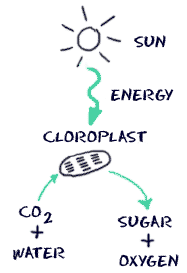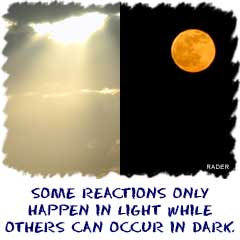Photosynthesis -
Part I: The Sun and Light
 Not all of the light from the Sun makes it to the surface of the Earth. Even the light that does make it here is reflected and spread out. The little light that does make it here is enough for the plants of the world to survive and go through the process ofphotosynthesis. Light is actually energy, electromagnetic energy to be exact. When that energy gets to a green plant, all sorts of reactions can take place to store energy in the form of sugar molecules.
Not all of the light from the Sun makes it to the surface of the Earth. Even the light that does make it here is reflected and spread out. The little light that does make it here is enough for the plants of the world to survive and go through the process ofphotosynthesis. Light is actually energy, electromagnetic energy to be exact. When that energy gets to a green plant, all sorts of reactions can take place to store energy in the form of sugar molecules. Remember we said that not all the energy from the Sun makes it to plants? Even when light gets to a plant, the plant doesn't use all of it. It actually uses only certain colors to make photosynthesis happen. Plants mostly absorb red and blue wavelengths. When you see a color, it is actually a color that the object does NOT absorb. In the case of green plants, they do not absorb light from the green range.
Part II: The Chloroplast
We already spoke about the structure of chloroplasts in the cells tutorials. We want to reinforce that photosynthesis happens in the chloroplast. Within this cell organelle is the chlorophyll that captures the light from the Sun. We'll talk about it in a bit, but the chloroplasts are working night and day with different jobs. The molecules are moved and converted in the area called the stroma.Part III: The Molecules
Chlorophyll is the magic compound that can grab that sunlight and start the whole process. Chlorophyll is actually quite a varied compound. There are four (4) types: a, b, c, and d. Chlorophyll can also be found in many microorganisms and even some prokaryotic cells. However, as far as plants are concerned, the chlorophyll is found in the chloroplasts. The other big molecules are water (H2O), carbon dioxide (CO2), oxygen (O2) and glucose (C6H12O6). Carbon dioxide and water combine with light to create oxygen and glucose. That glucose is used in various forms by every creature on the planet. Animal cells require oxygen to survive. Animal cells need an aerobic environment (one with oxygen).Part IV: Light and Dark Reactions
 The whole process doesn't happen all at one time. The process of photosynthesis is divided into two main parts. The first part is called the light dependent reaction. This reaction happens when the light energy is captured and pushed into a chemical called ATP. The second part of the process happens when the ATP is used to make glucose (theCalvin Cycle). That second part is called thelight independent reaction.
The whole process doesn't happen all at one time. The process of photosynthesis is divided into two main parts. The first part is called the light dependent reaction. This reaction happens when the light energy is captured and pushed into a chemical called ATP. The second part of the process happens when the ATP is used to make glucose (theCalvin Cycle). That second part is called thelight independent reaction. 






0 comments:
Post a Comment